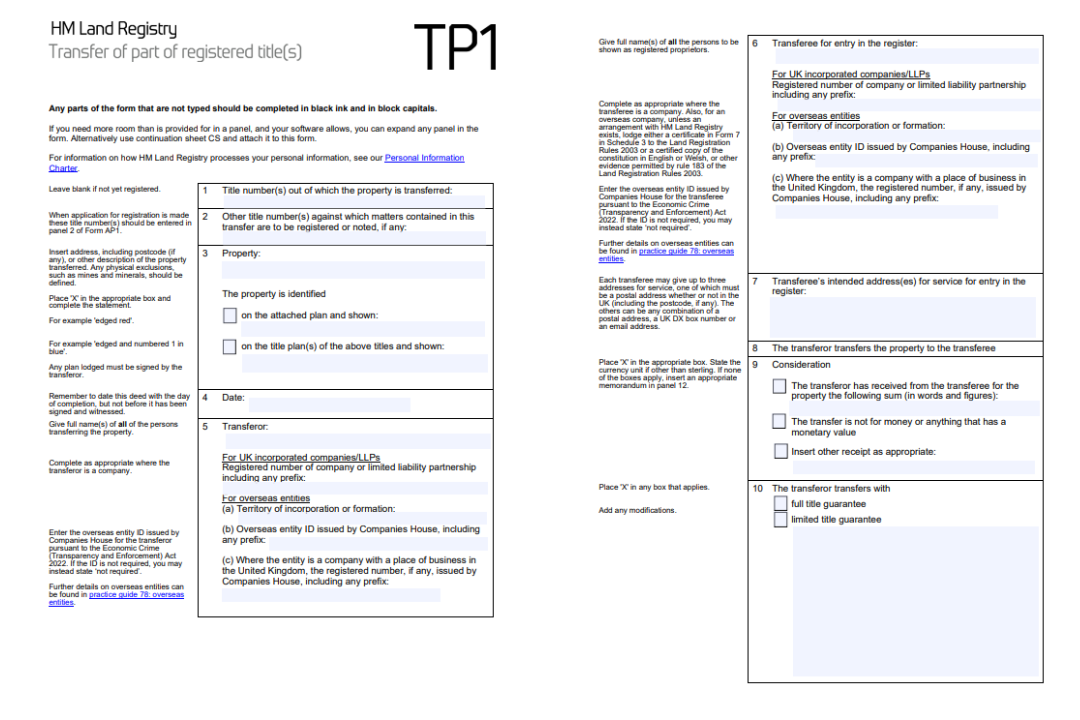
A TP1 form is a key legal document in the UK for transferring part of a property. Instead of dealing with the whole property, it’s used when only a portion - like a section of land or part of a building - is being sold, gifted or transferred. If you're involved in a property transaction like this, understanding the TP1 form is essential. In this guide, we’ll explain what the TP1 is, how it’s used and why it’s so important.
What is a TP1 form?
The TP1 form is used to transfer ownership of part of a registered property. It's used when you're buying or selling a section of land instead of a whole plot or if a property is being divided. The TP1 ensures that the transfer is legally recorded with HM Land Registry and outlines the specific details and terms of the transaction.
What is a TP1 used for?
A TP1 form is typically used in scenarios like selling a section of a larger plot, dividing properties or creating new property boundaries. By completing the TP1 form, the transaction becomes legally recognised, and the Land Registry updates its records to reflect the changes. Some common situations include:
Selling part of a property: For example, if a property owner wants to sell a garden plot or a separate portion of land.
Boundary adjustments: When property boundaries are being redefined, such as during a land subdivision.
Creating new titles: When part of the property is being separated to create a new title.
Shared ownership or gifting: For transferring part of the property to a family member or partner.
What does a TP1 include?
A TP1 form contains specific details about the property and the terms of the transfer. These are divided into sections, also known as 'panels'. These are the key panels that you or a property solicitor may need to fill out:
Panel | Title | Summary |
|---|---|---|
1 | Title numbers | This is the title number to which the property is transferred. |
2 | Other title numbers | The title number of any other land affected by the transfer. |
3 | Property | Include the property's full address. |
4 | Date | Here you'd include the date that the sale takes place. |
5 | Transferor | The full name of the person transferring the property. |
6 | Transferee | The full name of the person being transferred the property. |
7 | Address | The address of the buyer of the property. |
8 | Not applicable | This is a statement of transfer and does not need to be amended. |
9 | Consideration | Here you would enter the amount paid for the property being transferred. |
10 | Titles | This panel is where you confirm if the property is being transferred with full or limited title guarantee. |
11 | Declaration of trust | This panel should only be completed if there is more than one transferee. It's essentially a declaration of how the parties intend to hold the property after completion. |
12 | Additional provisions | This is where covenants (essentially a property rule) or agreements between the transferor and transferee would go. |
13 | Execution | All transferors must legally sign the deed. |

Note: Image correct as of 2024.
Is a TP1 legally binding?
Yes, the TP1 form is legally binding once it has been signed, witnessed, and submitted to HM Land Registry. By signing the TP1, the transferor and transferee formally agree to the terms. After submission, HM Land Registry processes the application and updates the property’s title to reflect the change in ownership.
Is a TP1 different from a TR1 form?
Yes, while both the TP1 and TR1 are transfer deed forms used in property transactions, they serve different purposes. A TP1 is for transferring part of a registered property, while a TR1 is for transferring the entire property. Both forms are submitted to HM Land Registry but serve distinct purposes based on the scope of the transaction.
TP1 (Transfer of Part): Used when transferring ownership of a part of a registered property.
TR1 (Transfer of Whole): Used for transferring the entire property from one owner to another.
💡Editor's insight
"I find most people confuse a TP1 with a TR1. A TR1 transfers the whole property or piece of land - that's the key difference. For example, if you’re selling a section of your garden, you would use a TP1. If you’re selling your entire house, you would use a TR1. Both forms are submitted to HM Land Registry and require accurate information to ensure the transfer is processed correctly. You can learn more in our guide to what is a TR1."
Who needs to complete a TP1?
The TP1 form must be completed by:
The transferor (current owner): The person or entity transferring ownership of part of their property.
The transferee (new owner): The individual or organisation receiving the transferred property.
Additionally, legal professionals such as solicitors or conveyancers often complete the TP1 on behalf of their clients. This ensures the form is filled out accurately and complies with all legal requirements.
Why is a TP1 important?
A TP1 is important because it formalises the transfer of part of a property and ensures the transaction is legally recognised. Without a TP1, the transfer of part of a property may not be enforceable, leaving both parties vulnerable to legal issues. Key reasons for its importance include:
Legal clarity: It clearly defines the terms of the transfer, including rights, restrictions, and boundaries.
Protects ownership rights: The form ensures the new owner’s rights are recorded and safeguarded by the Land Registry.
Facilitates development: In property development or subdivision, the TP1 is essential for creating new property titles.
Prevents disputes: By legally recording the transfer, the TP1 helps avoid future conflicts over property ownership or boundaries.
FAQs
Do I need a solicitor to complete a TP1?
Although not legally required, using a title transfer solicitor is highly recommended. They ensure the form is completed accurately, reducing the risk of errors or disputes.
How long does it take to process a TP1?
Processing a TP1 form with HM Land Registry typically takes two to six weeks, depending on the complexity of the transaction and workload.
Can a TP1 include restrictions or rights?
Yes, the TP1 can include rights (like access rights) or restrictions (like covenants) that apply to the transferred property. These details are crucial and must be clearly outlined in the form.
What happens if there’s an error on the TP1 form?
Errors can delay the registration process and may require legal intervention to resolve. Always double-check the form or seek professional advice before submission.
Final thoughts
A TP1 form is a vital legal document for transferring part of a property, ensuring the transaction is legally recognised and recorded with HM Land Registry. While it may seem straightforward, the form’s detailed requirements mean professional advice is often necessary to avoid errors or disputes.
By understanding the purpose and importance of a TP1, both transferors and transferees can navigate property transactions with confidence. If you need property help, our transfer of equity solicitors are here to help.
References
Part transfer (TP1) from Gov.UK